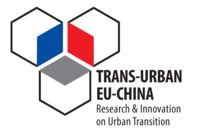
TRANS-URBAN-EU-CHINA
Transition towards urban sustainability through socially integrative cities in the EU and in China
Capacity Development
1. Purpose(s)
Capacity development aims at strengthening the existing skills, capacities and knowledge of diverse stakeholders involved in urban planning and implementation process. Capacity development process enables a range of urban public and private stakeholders and actors to acquire new skills necessary for the planning and implementation of integrated and sustainable urban projects. The inherently complex nature of urban planning and implementation requires capacity development on different levels, including but not limited to; adaptive capacity, leadership and coordination capacity, management capacity, technical capacity and engagement capacity amongst others.
Key Words: capacity; skills; learning; exchange
2. Relevance and Impact
Integrated planning and implementation of urban development projects requires involvement, know-how, skills and alignment between a wide range of stakeholders: city administration, developers, experts, academia, communities as well as individuals. Improving and continuously evolving capacity development within and among different stakeholder groups can assure more effective implementation processes and serve integrated planning, while narrowing the gap between planning and implementation. Capacity development is an instrument that creates the fundamental conditions for stakeholders to realize their potential to generate cities for all.
In the case study cities, capacity development was used as a tool in the cities of Stockholm, Beijing, Dalian, and Shenzhen. As for China capacity building is often utilized to foster multi-actor involvement in innovation (refers to innovative activities that aims at facilitating applying S&T achievements to production). Those capacities to be built mainly include: Inter-organizational capabilities, that is, to promote knowledge sharing and peer exchanges through cooperative network construction, collaborative learning, field trips, etc., and this is closely related to stimulating disruptive innovation in the field of technology. In the context of China, inter-organizational communication often needs to overcome fairly high transaction costs. In Europe capacity building is for different stakeholders as developers, consultants, city representatives and city personnel involved in urban planning.
The tool as such was not tested as planned on a large scale within the project because of COVID-19. The tool was presented as an approach in the online workshop in August 2020 and examples were shared with Chinese partners. Due to COVID 19, it was not possible to test it in a Living Lab workshop in China.
3. Strenghts
Capacity development enables individuals, organizations, companies and citizens to obtain, improve, and retain the skills, knowledge, tools, equipment, and other resources needed to perform their tasks individually and collectively competently. This enables to exchange the know-how and to integrate the knowledge and skills into practice.
4. Weaknesses
Capacity development is a long-term development process that requires adequate resources, investment, ongoing attention, coordination and commitment. There is no one-suit-all solution for capacity development. Different cities usually develop tailormade solutions and approaches that best suit their current state of planning and development culture.
5. Good practice examples
Stockholm (map): Royal Seaport - Capacity development program
One of the best practice examples for the application of this tool and mechanism is the ongoing Capacity Development Program of the City of Stockholm, which is active since 2010. This program is compiled of a wide range of capacity building activities including seminars for developers and consultants, city representatives and city personnel involved in urban planning. An important building block of this capacity development program is a Forum for Sustainable Urban Solutions. The Forum provides space for ‘matchmaking seminars’ that enable different stakeholders to meet and exchange their know-how on different sustainable solutions, services and products. The Forum was launched in 2012, with more than 25 meetings taking place, enabling participation of more than 1900 people and 100 companies
6. References
7. Author(s) of the article
Daiva Jakuyte-Walangutang
